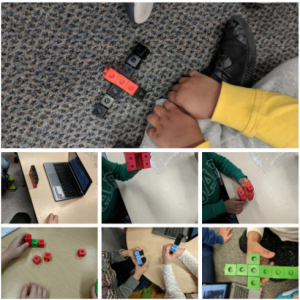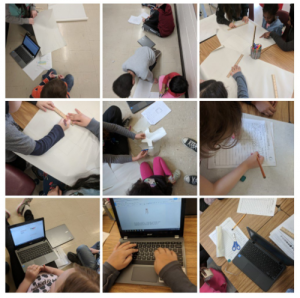When you walk into a classroom what is the first thing you see? Decorated bulletin boards?
Looking at bulletin boards often reflect what is happening in a classroom. Bulletin boards often show teachers’ focus on particular curriculum and what students are doing in the classroom. But what do bulletin boards say about teachers’ practices or schools’ efficacy?
Bulletin boards as a reflection of a school or classroom
A New York Times article by Abby Goodnough, Judging a School by Its Posters; Bulletin Boards Are Scrutinized, and Fretted Over, discusses how schools’ and/or teachers’ are judged through how hallways and classrooms are decorated instead of actually examining the pedagogy that is in place.
The article goes on to state bulletin boards “have a far weightier role … as the educational standards movement has required students to master ever-longer lists of skills — and required teachers to explain exactly how they are teaching them — bulletin boards have become an intensely monitored showplace for progress. They are especially important in low-performing schools, which are constantly scrutinized by city and state education officials and under heavy pressure to show improvement.”
Teachers … “complain that administrators dwell too much on how the boards look.” “Sometimes, teachers say, principals make them redo boards that are judged too quirky or dull. Some principals also demand new displays if ” they are damaged.
Bulletin Boards to Make Learning Visible
In a Making Learning Visible Project at the Harvard Graduate School of Education, it states that bulletin boards make learning visible by communicating and creating “values about teaching and learning” by making “individual thinking available to the group and support collective knowledge-building” and helping “learners to make connections across units and subject matter.” Further, bulletin boards “provide opportunities to connect learning experiences across classrooms or time.” Here, the role of bulletin boards is to make students’ learning visible.
Teacher Based vs Students’ Work
Another issue with bulletin boards is not just about the audience but about the content. Some teachers put up inspirational posters and/or curriculum content which is teacher based. Other teachers put up only student work. And some teachers have a combination of both.
Student Driven Bulletin Boards
When I first started teaching, my bulletin boards centered on what we were studying in the classroom with some space dedicated to students’ work. But I have developed an approach of only student centred bulletin boards where students create them with the teacher using students’ work. This means that the space becomes the students, not driven by the teacher. I even have my students decide on the bulletin board boarders.
The Learning Environment as The Third Teacher
An important issue to consider when putting anything up in a classroom is students’ over-stimulation. Given that students with Attention Deficit Disorder (ADD) and/or Attention Deficit Hyperactivity Disorder (ADHD) can experience over stimulation due to “too much stuff on the classroom walls”, teachers should take this into account when they choose what should go on bulletin boards and how it impacts students’ concentration and focus. Sometimes the classroom environment can just be too stimulating!
The Ontario Capacity Building Series notes how the learning environment, The Third Teacher, “can either enhance the kind of learning that optimizes our students’ potential to respond creatively and meaningfully to future challenges or detract from it.”
Finally, when considering classroom decorating, please be mindful of Health and Safety regulations about too much paper on the walls (i.e. usually less than 20%).
Here are some ideas to promote student focused, learner centred bulletin boards:
- The Fridge – a bulletin board where each student has their own space to display their work
- To Do List s– where students list work that needs to be done for the day/week (my students love this as they create it themselves)
- Student developed Word Walls for curriculum topics
- Student developed Math Walls – listing vocabulary, formulas, graphics that students find important
- Height Wall – showing how much students have grown in the year (it’s fun to track how fast students are growing and it’s also a great visual to understand linear metric measurement)
- Data Wall – graphs displaying classroom surveys such as “What is your favourite pizza topping?”
- Student made calendar – tracking upcoming events for the week and month
- Class goals for the week or month
For me, in the end what matters is that the students feel like the classroom belongs to them as they have designed it – like an extension of their home space.
I dedicate this blog to my son’s (favourite ever) grade 5 teacher, Ms. G, who recently shared with me the following:
“I can vividly remember TS – he was such a nice boy, full of life, and so smart. It was also at the beginning of my teaching career, and taught me a lesson I’ll never forget. Being a new teacher, I wanted my boards to look beautiful for my students. I went and bought all the boarders and colourful art work to decorate them. One day, TS told me he couldn’t concentrate – that the bulletin boards were too distracting. I had never even thought about how the beautifully decorated boards could have been a distraction.
From then on, I thought about my classroom set up, and how I could make it a calming place. I stripped the boards, made them one colour and became much more thoughtful on trying to create a calming place for my students. I also created different spaces to cater to my students’ needs. Thank you to TS who opened my eyes. The student teaches the teacher.”
Even after 20 years, I too get “taught” by my students every day. My son, TS, turns 26 years old this month!
Collaboratively Yours,
Deb Weston








 Next week we are on to our build and learning about hand tool safety in kindergarten. It’s sure to be a new adventure and I can’t wait to see and share the actual solutions that they create.
Next week we are on to our build and learning about hand tool safety in kindergarten. It’s sure to be a new adventure and I can’t wait to see and share the actual solutions that they create.